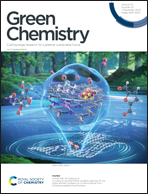Synthesis and properties of linseed oil-based waterborne non-isocyanate polyurethane coating†
Abstract
Significant strides in the development of non-isocyanate polyurethane (NIPU) have been made in the coatings industry. Aligned with green chemistry principles, this study explores the use of bio-based, low volatile organic compounds and fast-curing waterborne NIPU for coating applications. The linseed oil-based cyclic carbonate was synthesized via a thiol–ene click reaction and was followed by an esterification reaction directly from linseed oil. In this structure, the cyclic carbonates are introduced as pendant functional groups to accelerate the curing. Next, a series of linseed oil-based waterborne NIPUs were synthesized and developed from the linseed oil-based cyclic carbonate, a bio-based fatty acid diamine, and an internal dispersion agent. Different formulations of the linseed oil-based NIPU coatings were designed by varying the internal dispersion agent content and urethane content, and a solvent-borne NIPU was included in the study for comparison purposes. The NIPU coatings with different formulations achieved a broad range of thermal stabilities, viscoelastic properties, and mechanical properties. The general coating properties—including hardness, solvent resistance, impact resistance, and adhesion—were evaluated to demonstrate the practical application of the waterborne NIPU in coatings. The linseed oil-based waterborne NIPU coatings exhibited performance comparable to both a solvent-borne NIPU coating and a commercial waterborne isocyanate-based polyurethane coating.



 Please wait while we load your content...
Please wait while we load your content...
